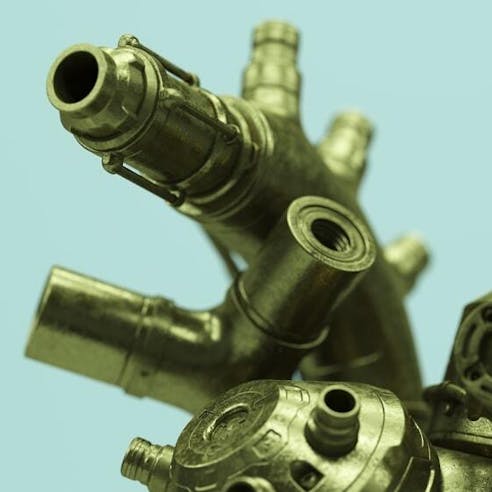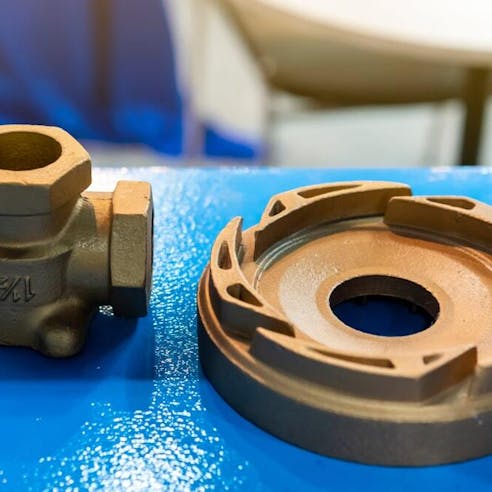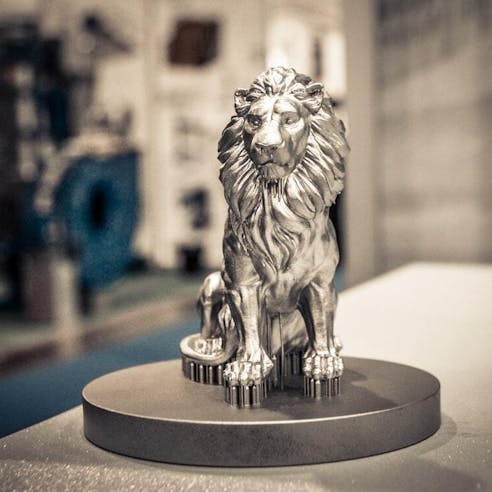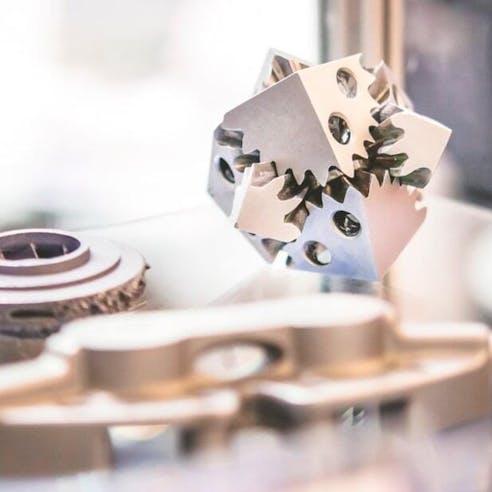Bronze 3D Printing Service
Get instant online quotes on parts in over 70 metal and plastic materials. Free shipping on all US orders. ISO 9001:2015, ISO 13485, IATF 16949:2016, and AS9100D certified. Subject to availability. Xometry doesn't guarantee that we can provide this service at any given time.
Xometry offers the highest quality Bronze 3D Printing Service for a variety of hobby and industrial applications. Our Manufacturing Supplier Network gives you the capability to 3D print bronze with the exact alloy, fabrication process, and finish necessary for your end use.
Bronze is a metal made from alloying copper with around 10% tin and sometimes trace amounts of metals and non-metals like aluminum, phosphorus, silicon, etc. Bronze is an oxidation-resistant, highly aesthetic metal that is easily workable and does not wear easily. It also will naturally tarnish and is an affordable option for aesthetic applications.
Bronze is readily 3D printed using fused deposition modeling (FDM) bronze filament or by using powder bed fusion techniques such as direct metal laser sintering (DMLS).
3D printed bronze parts have key applications in industry, such as general components, jewelry and sculpture, and architectural and decorative trim pieces.
Bronze 3D Printing Technologies
Bronze 3D printing can be achieved using two principal techniques: fused deposition modeling (FDM) and direct metal laser sintering (DMLS). Each printing process can achieve great prints, but they each offer unique results and have different cost, size, and design requirements.
- Fused Deposition Modeling (FDM) Printing
- Direct Metal Laser Sintering (DMLS) Printing

Fused Deposition Modeling (FDM) Printing
In fused deposition modeling (FDM) 3D printing, a 3D computer-aided design (CAD) model is first uploaded into an innovative printer software that slices it into layers or cross-sections. Each layer is converted into machine code, which defines the path the printer must take in the X-Y plane. A spool of filament is loaded into the extruder nozzle, which is guided by the printer’s XYZ gantry to melt and deposit material onto the build platform in the layer’s shape as defined by the machine code. When this layer is complete, the build platform descends to accommodate the next layer, and the printer repeats the process until the full part is achieved.
Bronze filament is readily usable in FDM printing to achieve direct metal additive manufacturing, however it involves sintering (or heating the part without reaching melting temperature) to ensure good material adhesion. Also, FDM requires printing support structures for overhangs and incompatible geometries, further increasing post-processing steps. To learn more, see Xometry’s FDM 3D Printing Services.
Direct Metal Laser Sintering (DMLS) Printing
In direct metal laser sintering (DMLS), a CAD file is prepared by uploading it to a slicing software in a similar fashion to FDM printing. In this printing process, a layer of thin metal powder is laid onto the build platform (known in DMLS as a powder bed), and a laser selectively sinters the particles together in the shape of the layer. The powder bed descends, and another powder layer is spread over the previous layer, where the process repeats until the part is completed and buried in the unused powder. The material is taken out of the powder bed, cleaned of excess material, and then is either ready for use or ready for additional finishing processes such as sanding, bead blasting, tempering, etc.
A variety of bronze powder materials can be used in DMLS, and since no support structures are needed in powder bed fusion, this technique allows parts to be printed with massive overhangs, voids, and other features not possible on FDM printers. DMLS printed parts are as strong as typical bronze parts and are exceptionally accurate to the original design. To learn more, see Xometry’s DMLS 3D Printing Services.
Advantages of Bronze 3D Printing
Bronze 3D printing has several advantages over traditional bronze fabrication techniques.
- Bronze 3D printing can achieve complex geometries (such as interlocking parts or enclosed parts) and detail that would be impossible to make with machining, bronze casting, or subtractive processes
- Lead times are significantly reduced, even with additional post-processing steps
- Material waste is much lower than other subtractive processes, making bronze 3D printing a cost-effective manufacturing method

Disadvantages of Bronze 3D Printing
While 3D printing with bronze has several positive benefits, there are some limitations that need to be understood before selecting this process.
- The accuracy of bronze 3D printing will be lowered by the sintering process and is generally lower than thermoplastic printing
- Bronze 3D printing is (to date) restricted to the use of certain alloys specifically formulated for additive manufacturing
- Metal 3D printing can be expensive both in material and equipment costs


Ready to start making custom bronze 3D printed parts?
Free shipping on all US 3D printing orders
Bronze 3D Printing Applications
3D Printing with bronze lends itself to use in industrial applications for jewelry & artistic pieces, architectural components & fixtures, as well as general use consumer products.
- Jewelry
- Design Pieces/Decorative Trim
- Sculptures
- General Components

Jewelry
Bronze jewelry, such as beads, chains, gem settings, etc, can all be made using bronze 3D printing techniques. 3D printing jewelry reduces its manufacturing time while not sacrificing on accuracy or aesthetics, allowing designers to make more creative, intricate designs in less time.
Design Pieces/Decorative Trim
Architectural decorative trim and other design pieces are common applications for bronze 3D printing. These objects can be made more accurately and in less time than with traditional bronze manufacturing methods, making bronze 3D printing ideal for fast-turnaround artistic projects.
Sculptures
Bronze sculptures and bronze models can be easily 3D printed and represent one of the most common applications of the technology. Not only is 3D printing sculptures faster, but it is also less expensive, produces less waste, and offers a much wider range of possibilities for the sculptor.
General Components
Bronze components like fasteners, hinges, plates, or other general workpieces can be scaled quickly using metal 3D printing techniques. Multiple parts can be printed at the same time, offering designers a higher output per-unit time with lower initial investment costs as compared to processes like metal stamping, cutting, turning, milling, machining, etc.
Alternatives to Bronze 3D Printing
If 3D printing is not suited for your application, here are alternative methods that may still work such as metal casting. If unsure of what to use, reach out to our application engineering team and process specialists so that we can help identify the best possible manufacturing process solution for your needs.
- Lost Wax Casting
- Lost PLA Casting
- Metal Injection Molding

Lost Wax Casting
In lost wax bronze casting (also known as investment casting), a bronze part is made by creating a mold, filing it with molten wax, then taking this wax double once cooled and placing it in a ceramic mold slurry. This slurry will cure into a hard shell around the wax double, and then this wax is melted out by placing the piece in a furnace. What is left is a ceramic mold that is the shape of the part, which can be filled with molten bronze and then broken off once the bronze casting has cooled, leaving behind a full-bronze part. Lost wax bronze casting is an ancient process that is still used throughout industry as a tried and tested additive manufacturing method of bronze and other metals.
Lost PLA Casting
Lost PLA bronze casting is in many ways the same as lost wax casting, however it uses a 3D printed core of PLA plastic as the basis for its mold and not wax. A core is printed using PLA filament, and is then submerged in the ceramic slurry mixture and left to dry. This piece is placed in the furnace where the PLA melts out, leaving a ceramic mold ready for bronze casting. Lost PLA casting allows designers to better control the shape of the mold, resulting in more symmetrical, complex parts.
Metal Injection Molding
Injection molding with metal can create bronze parts using injection molding techniques. Fine metal powder is mixed with binders (wax and plastic) to allow it to flow into traditional injection molding machines. When the injection molding process is finished, the part is removed frrorm the mold and is then sintered in a furnace, eliminating the binders and leaving behind a full bronze part. Metal injection molding is best suited for high-volume applications that require tight tolerances and high repeatability across manufacturing runs.
To learn more about this process, see Xometry’s Metal Injection Molding Services.
Why Xometry for Bronze 3D Printing

Endless Options
Choose from millions of possible combinations of materials, finishes, tolerances, markings, and certifications for your order.

Easy to Use
Get your parts delivered right to your door without the hassle of sourcing, project management, logistics, or shipping.

Quality Assurance
We are ISO 9001:2015, ISO 13485, IATF 16949:2016, and AS9100D certified.
Get Started on Your Bronze 3D Printing Quote
Free shipping on all US 3D printing orders